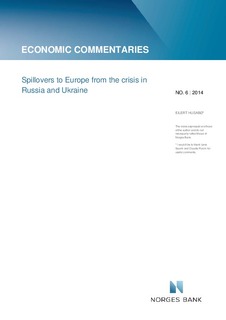| dc.contributor.author | Husabø, Eilert | |
| dc.date.accessioned | 2018-08-15T08:30:31Z | |
| dc.date.available | 2018-08-15T08:30:31Z | |
| dc.date.issued | 2014 | |
| dc.identifier.uri | http://hdl.handle.net/11250/2558081 | |
| dc.description.abstract | The IMF recently pointed to the unrest in Ukraine as a risk to global growth prospects. This article provides a short overview of transmission channels for the effects of the crisis and potential spillovers if the crisis should intensify. Most European countries will likely be little affected directly via trade and capital flows, owing to their relatively small exposure to Russia. Should Russian gas exports to Europe cease for a long period, however, the potential negative effects on growth in Europe may be substantial. The same applies if the crisis intensifies to the extent that it undermines global confidence and risk sentiment. | nb_NO |
| dc.language.iso | eng | nb_NO |
| dc.publisher | Norges Bank | nb_NO |
| dc.relation.ispartofseries | Economic Commentaries;6/2014 | |
| dc.rights | Attribution-NonCommercial-NoDerivatives 4.0 Internasjonal | * |
| dc.rights.uri | http://creativecommons.org/licenses/by-nc-nd/4.0/deed.no | * |
| dc.title | Spillovers to Europe from the Crisis in Russia and Ukraine | nb_NO |
| dc.type | Others | nb_NO |
| dc.description.version | publishedVersion | nb_NO |
| dc.subject.nsi | VDP::Samfunnsvitenskap: 200::Økonomi: 210::Samfunnsøkonomi: 212 | nb_NO |
| dc.source.pagenumber | 8 | nb_NO |

